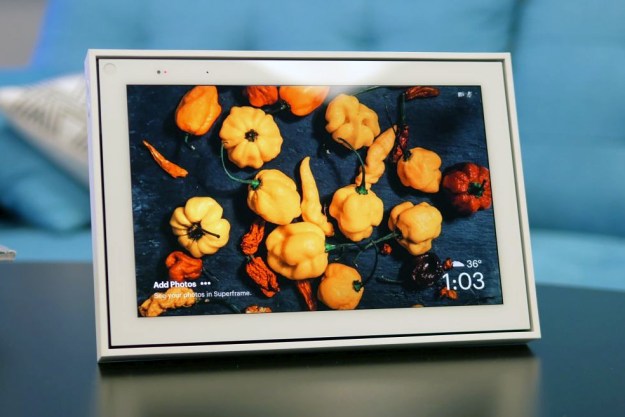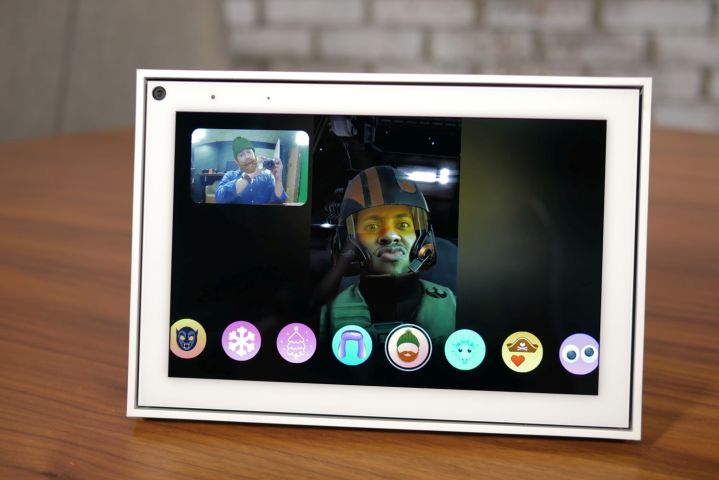
“Facebook's Portal makes video calls easily, but only for Facebook superfans.”
- Video calling fun with AR effects
- Excellent audio quality
- Sharp, color accurate display
- Amazon Alexa compatible
- Affordable
- Awkward power cord stand
- Lacks easy way to watch YouTube
- Boxy design
Remember when The Facebook was the cool and hip social media platform?
Well, I certainly don’t. That’s because my foray into Facebook didn’t happen until this decade – 2010, to be more precise – long after the social media giant opened up registration to everyone in 2006. Your parents, relatives, and even your creepy next door neighbor were all able to send friend requests, and if you happened to accept, it was possible for them to see all of your photos, snarky comments, and favorites. Needless to say, it didn’t take too long for
Don’t get me wrong. I’ll be the first to say I appreciate what
In short, the deck is stacked again
For Facebook users only
Before you even think about buying a Portal, know this. You need to be an active
The Alexa collaboration makes sense, because it functions nearly as well as on Amazon’s full featured

For something made by
I found this jarring at first, but after some time with the Portal, I was happy it didn’t replicate the full
Outstanding display perfect for photos
The Portal isn’t going to win a beauty contest. Compared to some of its contemporaries, it’s boxy, with hard lines that converge at 90-degree angles. On top of that, I’m not a fan of how the power cord connector doubles as the stand for the display. I’m afraid of it breaking off if the display somehow tumbles to the ground. I would’ve prefer the styling of its rivals in the space — like the Amazon Echo Show and Google Nest Hub Max.
You could use the
While its design isn’t attractive, I have to admit the 10-inch 1,280 x 800 display has the same compelling qualities as the Nest Hubs’ display. Like the Nest Hub’s Ambient EQ technology, the Portal’s adaptive display adjusts to match the color and lighting of the room, creating a photo realistic look that could be mistaken for an actual printed snapshot inside of a photo frame. The Portal matches the look of the Nest Hub with its wide viewing angles, clarity, and true to life colors.
For the price, you could use the
Video chat with AR fun
The Portal is centered on keeping in touch with people through

The 13-megapixel camera, combined with some AI magic and a 114-degree field of view, allows the view to dynamically track faces. It’s very similar to the Nest Hub Max’s tracking, which mimics digital zooms and pans to keep people in frame. While this isn’t cutting-edge, I appreciate that I don’t have to sit directly in front of the Portal. On top of that, the microphones picked up every word, so there was rarely any repetitions on my end. While the Nest Hub Max can compete with the Portal in video call quality, Amazon’s Echo Show devices are a step behind.
There’s a switch on the unit that will cover the camera as well as mute the microphones. Given recent privacy concerns over cameras being hacked, this is one way of easing concerns.
Music to my ears
Surprisingly, the Portal delivers hefty audio through a pair of front-firing speakers and a rear woofer. There’s plenty of bass, so it does justice to songs with heavy beats. Audio in the higher ranges are overwhelmed, however, resulting in less detail. Still, it’s a good speaker with enough volume and range to fill a large room with sound.

Growing the ecosystem
The
Worse, some apps don’t support portrait view. For most casual users, playing a clip on YouTube requires a few extra steps beyond just asking
Some apps don’t support portrait view.
When it’s not being used, Portal resorts to showing a slideshow of my recent pictures from
Portal is trying to do a lot, but as a smart display, it still needs some growing up before it can reach its rivals. For example, Google Assistant powered smart displays, like the Lenovo Smart Display 7, are intelligent enough to show on-screen traffic conditions of my morning commute the moment I wake up. It’s this kind of detail that make smart displays, well, smart.
Our take
I liked the $179 10-inch Portal better than expected. It’s perfect for video calls thanks to its dynamic camera, exceptional audio performance, and the fun you can have using the AR effects. It’s also a sharp looking digital photo frame that does justice in showcasing photos I’ve posted. The Portal’s functionality is more limited than Amazon and Google alternatives, however, with fewer apps and less robust web browsing.
Is there a better alternative?
For the best end-to-end solution, the $230 price Google Nest Hub Max is the ultimate smart display with its beautiful screen, built-in Nest Cam functionality, powerful sound system, and the intelligent actions of
How long will it last?
My only concern about the Portal’s durability is the power cord stand that holds it upright. You’ll want to make sure Portal is placed somewhere away from sharp edges, because the weightiness of the smart display combined with its plastic casing doesn’t instill confidence if it’s dropped. Besides that,
Should you buy it?
Not unless you’re a committed
Editors' Recommendations
- How to set up a Facebook Portal
- Facebook Portal vs. Amazon Echo Show
- Amazon takes $50 off Facebook Portal smart video prices for Black Friday
- Facebook says new Portal video-chat devices are coming in the fall



